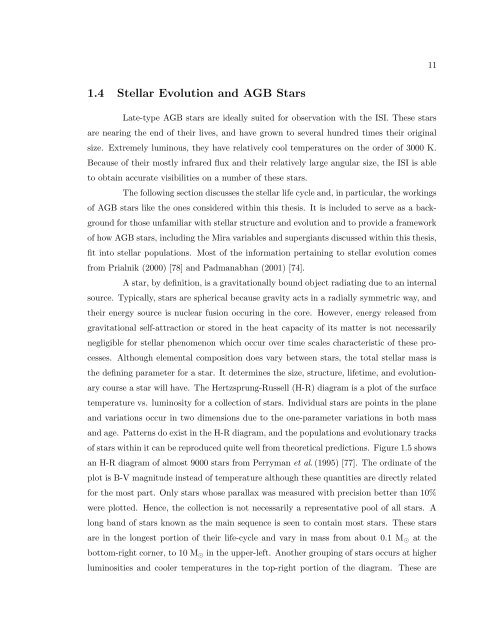The Size, Structure, and Variability of Late-Type Stars Measured ...
The Size, Structure, and Variability of Late-Type Stars Measured ...
The Size, Structure, and Variability of Late-Type Stars Measured ...
Create successful ePaper yourself
Turn your PDF publications into a flip-book with our unique Google optimized e-Paper software.
11<br />
1.4 Stellar Evolution <strong>and</strong> AGB <strong>Stars</strong><br />
<strong>Late</strong>-type AGB stars are ideally suited for observation with the ISI. <strong>The</strong>se stars<br />
are nearing the end <strong>of</strong> their lives, <strong>and</strong> have grown to several hundred times their original<br />
size. Extremely luminous, they have relatively cool temperatures on the order <strong>of</strong> 3000 K.<br />
Because <strong>of</strong> their mostly infrared flux <strong>and</strong> their relatively large angular size, the ISI is able<br />
to obtain accurate visibilities on a number <strong>of</strong> these stars.<br />
<strong>The</strong> following section discusses the stellar life cycle <strong>and</strong>, in particular, the workings<br />
<strong>of</strong> AGB stars like the ones considered within this thesis. It is included to serve as a background<br />
for those unfamiliar with stellar structure <strong>and</strong> evolution <strong>and</strong> to provide a framework<br />
<strong>of</strong> how AGB stars, including the Mira variables <strong>and</strong> supergiants discussed within this thesis,<br />
fit into stellar populations. Most <strong>of</strong> the information pertaining to stellar evolution comes<br />
from Prialnik (2000) [78] <strong>and</strong> Padmanabhan (2001) [74].<br />
A star, by definition, is a gravitationally bound object radiating due to an internal<br />
source. Typically, stars are spherical because gravity acts in a radially symmetric way, <strong>and</strong><br />
their energy source is nuclear fusion occuring in the core. However, energy released from<br />
gravitational self-attraction or stored in the heat capacity <strong>of</strong> its matter is not necessarily<br />
negligible for stellar phenomenon which occur over time scales characteristic <strong>of</strong> these processes.<br />
Although elemental composition does vary between stars, the total stellar mass is<br />
the defining parameter for a star. It determines the size, structure, lifetime, <strong>and</strong> evolutionary<br />
course a star will have. <strong>The</strong> Hertzsprung-Russell (H-R) diagram is a plot <strong>of</strong> the surface<br />
temperature vs. luminosity for a collection <strong>of</strong> stars. Individual stars are points in the plane<br />
<strong>and</strong> variations occur in two dimensions due to the one-parameter variations in both mass<br />
<strong>and</strong> age. Patterns do exist in the H-R diagram, <strong>and</strong> the populations <strong>and</strong> evolutionary tracks<br />
<strong>of</strong> stars within it can be reproduced quite well from theoretical predictions. Figure 1.5 shows<br />
an H-R diagram <strong>of</strong> almost 9000 stars from Perryman et al. (1995) [77]. <strong>The</strong> ordinate <strong>of</strong> the<br />
plot is B-V magnitude instead <strong>of</strong> temperature although these quantities are directly related<br />
for the most part. Only stars whose parallax was measured with precision better than 10%<br />
were plotted. Hence, the collection is not necessarily a representative pool <strong>of</strong> all stars. A<br />
long b<strong>and</strong> <strong>of</strong> stars known as the main sequence is seen to contain most stars. <strong>The</strong>se stars<br />
are in the longest portion <strong>of</strong> their life-cycle <strong>and</strong> vary in mass from about 0.1 M ⊙ at the<br />
bottom-right corner, to 10 M ⊙ in the upper-left. Another grouping <strong>of</strong> stars occurs at higher<br />
luminosities <strong>and</strong> cooler temperatures in the top-right portion <strong>of</strong> the diagram. <strong>The</strong>se are













![Problem #1 [Structure Formation I: Radiation Era]](https://img.yumpu.com/37147371/1/190x245/problem-1-structure-formation-i-radiation-era.jpg?quality=85)


